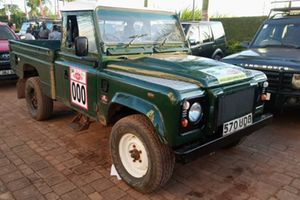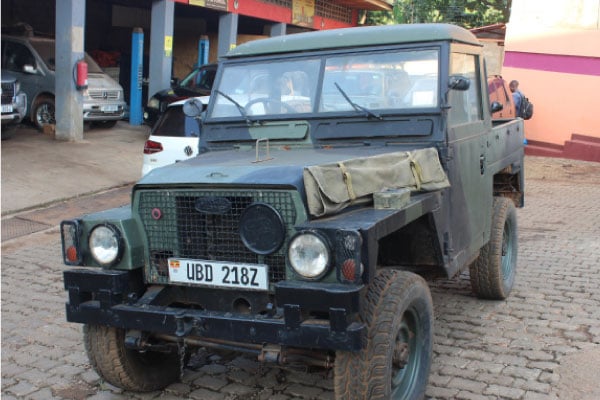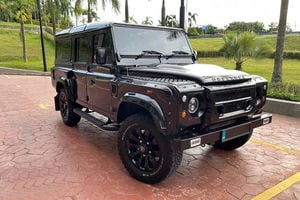
Mugwanya says that although he has been offered a lot of money, its not up for sale. Photo/ROLAND D. Nasasira
In the 1990s, Martin Mugwanya recalls his father, the late Pius Kawere driving him and his siblings to and from Kabojja School in Kampala in a Land Rover Defender. Kawere’s driving vintage vehicles was inspiring enough to Mugwanya that he grew up yearning to drive the same cars. Unfortunately, by the time Mugwanya learnt to drive in 2005, his father had sold all the cars.
Much as his first car was a Mitsubishi Pajero Intercooler, Mugwanya did not give up on ever owning a Land Rover Defender.
In 2019, shortly before the Covid-19 pandemic set in, Mugwanya chanced on a classics car collector who had put up a single-cabin Land Rover Defender 110 for sale.
“I could not let the opportunity pass me by. I bought it because my father drove Land Rovers and I can comfortably say I am driving my dream car.I do not wish to buy another vehicle. I have been offered large sums of money but I cannot trade my vehicle for anything else,” Mugwanya says.
Specs
A 1987 model and pick-up truck by design, when he had just acquired the car, it was not in the best mechanical condition. He says although it is still not yet in perfect condition, it is roadworthy, especially since the restoration of classics is an endless project.
For example, he restored the engine because the initial one bought would overheat whenever he drove upcountry.
Apart from replacing the tyres, radio and repainting the car, Mugwanya also gave the interior, including the roof, a facelift to make the car look attractive.
Growing up, he loved Land Rover brands with the spare tyre on the bonnet, just in front of the windscreen and it was not optional during restoration. The car has a second spare tyre at the rear. The cabin is covered with wooden panels, which serve as a cover.
“I chose wood as the cabin cover out of creativity. That is why the two spare tyre covers are also made of wood. I preferred wood over ordinary tarpaulins because I love art and craft. If I could get the wooden rims, I would. I have restored the car over time to a point where I can now drive it daily without any issues,” he explains.
Engine
A two-seater by capacity and a five-manual gear by transmission, Mugwanya’s Land Rover covers approximately 10km per litre of fuel. Built with a 2,500cc TDI engine, it runs on beautiful mud-grip tyres, something he says has a less advantage because he mostly drives the 37-year-old pickup off-road.
When he drives on-road, mud-grip tyres make noise and consume slightly more fuel than all-terrain tyres, normally abbreviated as, AT. The relationship between the types used and fuel consumption depends on tyre grips. All-terrain tyres consume less fuel because they are designed for all road conditions.
During restoration, he also remodelled the gearbox because the initial one was not meant for speed. Because he drives to Rakai District every week, he spends much time on the road, and so, needs some speed.
Service and maintenance
How often Mugwanya carries out service is dependent on the mileage covered and sometimes, according to performance, especially when he realises it is not performing at its optimum. He does farming in Kyotera, Rakai District and lives in Namugongo, Kampala, which means he is on the road every week.
Instead of the traditional 5,000km, Mugywanya visits the garage every 4,000km. He, however, carries out some of the service routines such as changing brake pads, fan belt, engine oil, oil filters, and fuel filters.
Challenges
The biggest challenge he faces with servicing his car is with spare parts where he sources some from the UK or Dubai. When he is lucky, he gets some old parts from different garages around Kampala, especially from vehicles no longer in use. It is not only expensive to get them but also expensive to modify them to serve the intended purpose.
“Sourcing for spare parts from abroad is like gambling. You either succeed or get conned. I always rely on eBay from the United Kingdom (UK). I normally send the part number and a friend based in the UK helps me buy the parts and sends them. Sometimes what I order is not exactly what is delivered. In such a case, I modify and go with what is available, especially when I cannot get the particular part anywhere in Kampala,” Mugwanya explains.
In the motor vehicle service industry, there is the aspect of spare parts not being readily available but mechanics can sometimes be another stumbling block. Luckily, Mugwanya trained himself to service some parts, and he is quick to recommend this to every motorist. He moves with his toolbox and only calls a mechanic when he is unable to fix the problem.
Takeaway
Even at the garage, Mugwanya advises vigilance; keep a close eye on the mechanic’s work to ensure that your parts are not replaced with used ones, regardless of whether you drive a Land Rover or another brand. This practice helps you avoid being deceived and ensures your vehicle remains in good condition for years. Similarly, the quality of service provided can sometimes determine how long you will continue to drive your car.




